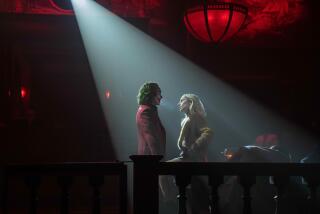MAKING ‘EM LIKE THEY USED TO
There are moments when it begins to seem possible that innocence is returning among us, like fresh greenery advancing over a bare, ruined landscape.
It was refreshing when, in their time, stage, screen, radio and print threw off the shackles and were able to play show-and-tell with reality. Things didn’t work out in the last reel, poetic justice was no longer served, the good guys didn’t win, Mom and Pop were psychotic horrors and their kids were worse, only violence solved anything and love was an archaic commodity reserved for those who hadn’t yet discovered sex.
The trouble was that cynicism got to be as tiresome and lopsided as good cheer.
An all-out return to innocence, romantic idealism and optimism would undoubtedly wear out its welcome quickly enough--and probably couldn’t get off the ground anyway because we are all so suffused with instant reality.
Yet attending the revivals of “The Boys From Syracuse” and “Leave It to Jane” at UCLA’s James A. Doolittle Theatre on Vine Street does remind you just how enchanting an artful innocence can be.
These productions, overseen by the veteran producer-director George Schaefer in his new role as dean of theater, film and television at UCLA, are not perfect, as Dan Sullivan has said in his reviews. But they have enormous verve and enthusiasm. And the young people who star in them and fill their ensembles are notably attractive and talented, with fine, strong voices, physical grace and a kind of buoyant assurance.
The charming make-believe of the early Judy Garland-Mickey Rooney musicals was that the kids shouted, “Who needs a theater, we can do it right here in the barn.” But once the music started they turned out to have a whole row of sound stages and a cast of thousands.
What links the Vine Street revivals to those remembered musicals is simply the spirit of youthful exuberance--and a degree of professionalism that may seem surprising.
The casts are salted with stage veterans (grand to see), but the leads are in the hands of the young, and it is interesting and reassuring to read in the program notes just how much work the youngsters, recently graduates of UCLA and elsewhere, have already been able to do.
Despite the university origins, there is nothing undergraduate about the competence of the work, and very little you have to make allowances for in the presence of these gifted young people. Their company is a pleasure.
The vague alarm you feel, amid the enjoyments of the evenings, is whether there will be as much work in musical comedy as this new generation deserves.
Michelle Nicastro, the Jane of “Jane,” is yet another alumna of Northwestern and its Waa-Mu show, and she is terrific. I hope and think we see her in the early days of a fine career. She has guest-starred in “Murder, She Wrote” among other things, but she should sing.
Chuck Wagner, her hero in “Jane” and one of the twin leads in “Boys From Syracuse,” is another engaging player, also strong-voiced and appealing. Patty Tiffany, who does “Cleopatterer” (P.G. Wodehouse at his lyrical best) in “Jane,” is a very promising comedienne, as is Dana Stevens. It is a sizable list of applaudees.
Schaefer says that he and his associates auditioned something like 500 players for the company, and could have cast three companies from the talent they met. That’s mixed news; you wish them all the chance to perform.
Innocence, of course, never arises in innocent times. In 1917, when Wodehouse and Guy Bolton and Jerome Kern were creating “Leave It to Jane,” the country and the world were at war. In 1938, when Richard Rodgers, Lorenz Hart and George Abbott were putting together “The Boys From Syracuse,” the world was at war again.
The idea of true love and the possibilities of happy endings may have been the stuff of escapist fare then as now. Yet somehow if they were romantic dreams, they were not impossible dreams. Those marvelous standards from “The Boys From Syracuse,” “Falling in Love With Love” and “This Can’t Be Love,” caught all the sweet pain of it, and neither the songs nor the subject matter have gone out of style. How nice to get reacquainted.
They may not make musicals the way they used to, but it’s a pleasure to be reminded how good the used-to was.
More to Read
The biggest entertainment stories
Get our big stories about Hollywood, film, television, music, arts, culture and more right in your inbox as soon as they publish.
You may occasionally receive promotional content from the Los Angeles Times.










